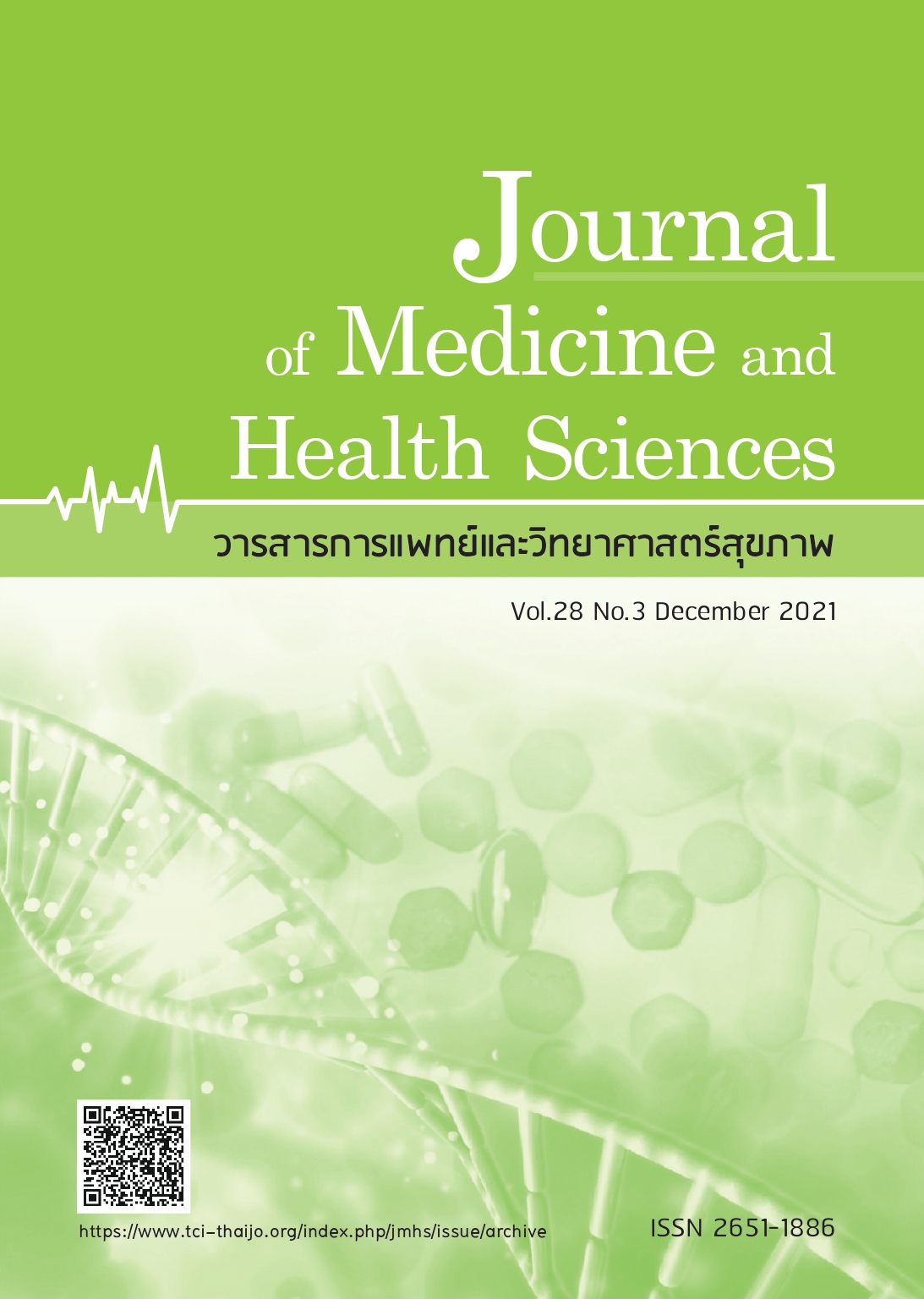Rehabilitation model for patients with chronic lower back pain in the community using innovative care for a chronic conditions framework
Keywords:
rehabilitation model, chronic lower back pain, innovative, chronic condition careAbstract
Abstract
The purpose of this descriptive research is to study the guidelines for the development of a rehabilitation model for patients with chronic lower back pain (P-CLBP) in the community and applying innovative care for a chronic conditions framework. The key information consisted of 20 patients and their relatives, 15 health care teams, and 15 community partners.This qualitative research collected data through in-depth interviews and a discussion group of village health volunteers. The researchers then drafted a rehabilitation model for P-CLBP and presented it to experts through the group discussion method. Then, the data were analyzed using content analysis methods. The results of the study were as follows: at the micro level, it concerns individuals, patients, relatives, health care teams and community networks. All three sectors should play the following roles: 1) to create the motivation and drive for rehabilitation of P-CLBP; 2) to prepare and train patients and relatives in terms of skills and gaining knowledge and information on self-rehabilitation; 3) to reduce the feelings of inferiority among patients; and to 4) to integrate cooperation in caring for P-CLBP at the meso-level or the level of the family unit, health organizations and community partners. These roles should be as follows: 1) to promote network capacity in the community; 2) to promote a continuous patient care system in the community; 3) to support and motivate through leadership; 4) to mobilize and coordinate resources in the community; 5) to develop a service system and to prepare for patient care; and 6) to support prevention and self-management among patients with CLBP and their relatives. At the macro or policy level of the organization and community, their roles should be as follows: 1) to establish community agreements or constitutions; 2) to formulate joint policies and plans; 3) to promote and support operations; 4) to allocate budgets for the rehabilitation of P-CLBP; and 5) to develop the expertise of the personnel; and 6) to provide adequate medical equipment to meet the needs of P-CLBP.
References
2. Ezzati M, Lopez AD, Rodgers A, et al. Comparative risk assessment collaborating group. Selected major risk factors and global and regional burden of disease. Lancet 2002;360:1347-60.
3. Chaiklieng S, Suggaravetsiri P, Pultumetakul R. Prevalence and risk factors of low back pain among informal garment workers in the northeast of Thailand. Occup Env Med
2013;70(Suppl 1):A1-149.
4. Keawduangdee P, Puntumetakul R, Swangnetr M, et al. Prevalence of low back pain and associated factors among farmers during the rice transplanting process.J Phys Ther Sci 2015;27:2239-45.
5. Khruakhorn S, Sritipsukho P, Siripakarn Y, et al. Prevalence and risk factors of low back pain among the university staff. J Med Assoc Thai 2010;93(Suppl 7):
S142-148.
6. Siriphanich S, Meanpheung P, Sayumpurujinan S. Occupational and environmental disease dituation 2003-2009 occupational disease and environmental monitoring system. WESR 2011;42:209-23.
7. Untimanon O, Boonmeephong K, Saipang T, et al. Burden of back pain among working populations. Dis Control J 2016;42:119-29.
8. Qaseem A, Wilt TJ, McLean RM, et al. Noninvasive treatments for acute, subacute, and chronic low back pain: A clinical practice guideline from the American College of Physicians. Ann Intern Med 2017;166:514-30.
9. Maher C, Underwood M, Buchbinder R. Non-specific low back pain. Lancet 2017; 389:736-47.
10. Plykaew R. Working posture and musculoskeletal disorders among rubber plantation workers [Thesis]. Chiang Mai : Chiang Mai University; 2013.
11. World Health Organization. Innovative care for chronic conditions: building blocks for action: global report. World Health Organization; 2002.
12. Nuño R, Coleman K, Bengoa R, et al. Integrated care for chronic conditions: The contribution of the ICCC framework. Health Policy 2012;105:55-64.
13. Sunsern R, Timsuwan B, Lawang W. Developing disabled caregiving system based on families and communities. J Nurs Educ 2013;6:25-41.
14. World Health Organization W. Innovative care for chronic conditions: building blocks for action : Global report. World Health Organization; 2002. p. 117.
15. Patong Subdistrict Municipality Office. Patong Subdistrict Municipality, Songkhla Province (Tambon Patong) [Internet]. 2021 [cited 2020 Nov 24]. Available from: http://www.patong.go.th/content/ cate/2/?page=3.
16. Medical Statistics, Hat-Yai Hospital. Outpatient records registration, Phatong community medical center; 2020.
17. Physical therapy statistics report. Physical therapy statistics. Physical Therapy Department, Hat Yai Hospital. Songkhla Province, Thailand; 2020.
18. Ruangmee W, Khupantavee N. Health care situation of stroke patients in community of Khao-Ya Subdistrict, Sribunpot District, Phatthalung Province. ASJ-PSU 2016;27:
64-72.
19. Nimtrong K. Effectiveness of educative supportive programe on self-care behaviors and pain leval among patients with chronic low back pain [Thesis].Phitsanulok: Naresuan Univercity; 2012.
20. Lwandee P, Amrumpai Y. Job motivation and Job satisfaction among nurses in Banphaeo hospital public organization. Kuakarun J Nurs 2015;22:48-59.
21. Nobnorb N. The effect of self-efficacy upon motivation in exercise for patient with low back pain [Master of Science (Sport Science), Major field: Sport science,
Interdisciplinary program]. Bangkok: Kasetsart University; 2011.
22. Tangsrikiatikun P, Chaiwanichsiri P, Wongsudhiphakorn N, et al. Family volunteer handbook. Nonthaburi: Department of Health Service Support, Ministry of Public Health; 2016.
23. Wongwilairat K. Potential development for self-care low back pain people: Ban Nonsaad Moo 2, Nonsaad Sub-district, Nonsaad District, Udonthani Province. [Master of Public Health Thesis in Public Health Administration, Graduate school], Khon Kaen: Khon Kaen University; 2011.
24. Sricharumedhiyan C, Vaddhano PT. Leadership and community development. JMPS 2018;6(Suppl 1):527-38.
25. Chatchawanchanchanakit P. Leadership and Efficiency Management of Public Hospita. J Soc Acad 2014;7:1-10.
26. Sahunphun P. The process of referral system between hospitals. Hua Hin Sook Jai Klai Kangwon J 2019;4:51-62.
27. Khongyuen N. Primary care service system with development standards. P.H. Policy & Law 2017;3:374-87.
28. Ratchathawan R, Kaewkrajok T, Jongkatekit W, et al. The community participation process in well-being development. J South Technol 2018;11:231-8.



